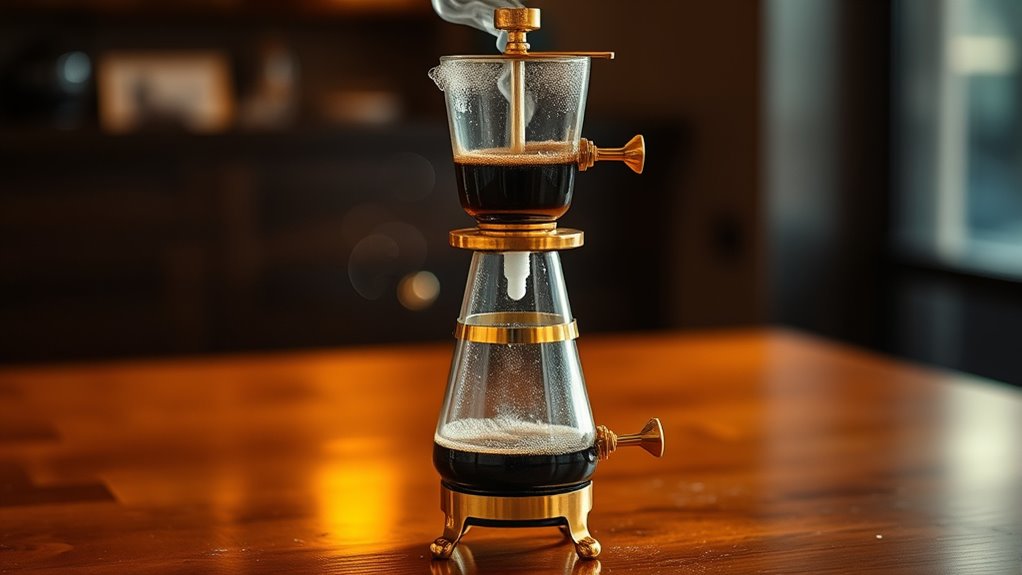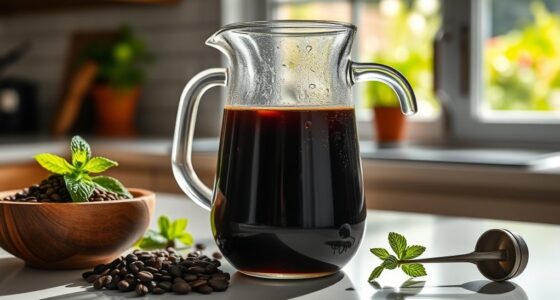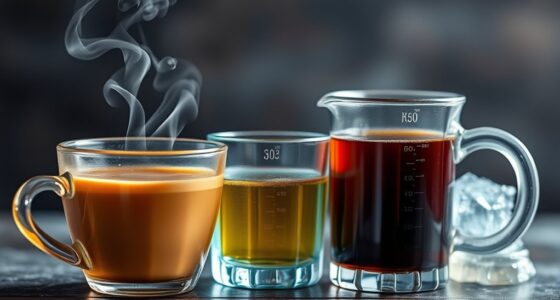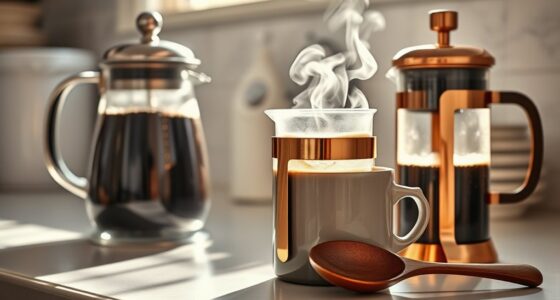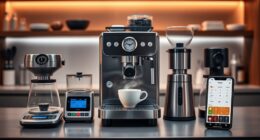Siphon coffee is a unique brewing method that uses a vacuum process to brew coffee with enhanced flavors. You’ll use a specialized siphon brewer, which has two chambers. When you heat water in the lower chamber, vapor pressure forces it to the upper chamber to mix with coffee grounds. As the brew cools, a vacuum pulls the coffee back down through a filter. This theatrical method not only makes great coffee but also offers an impressive coffee-making experience that you’ll want to explore further.
Key Takeaways
- Siphon coffee is brewed using a vacuum process that enhances flavor without boiling the water.
- The brewer consists of two chambers: one for water and another for coffee grounds.
- Vapor pressure heats water, forcing it to the upper chamber, where it mixes with coffee.
- Cooling creates a vacuum in the lower chamber, pulling brewed coffee back down through a filter.
- This theatrical method is popular in specialty cafes for its visual appeal and unique flavors.
The History of the Siphon Brewer
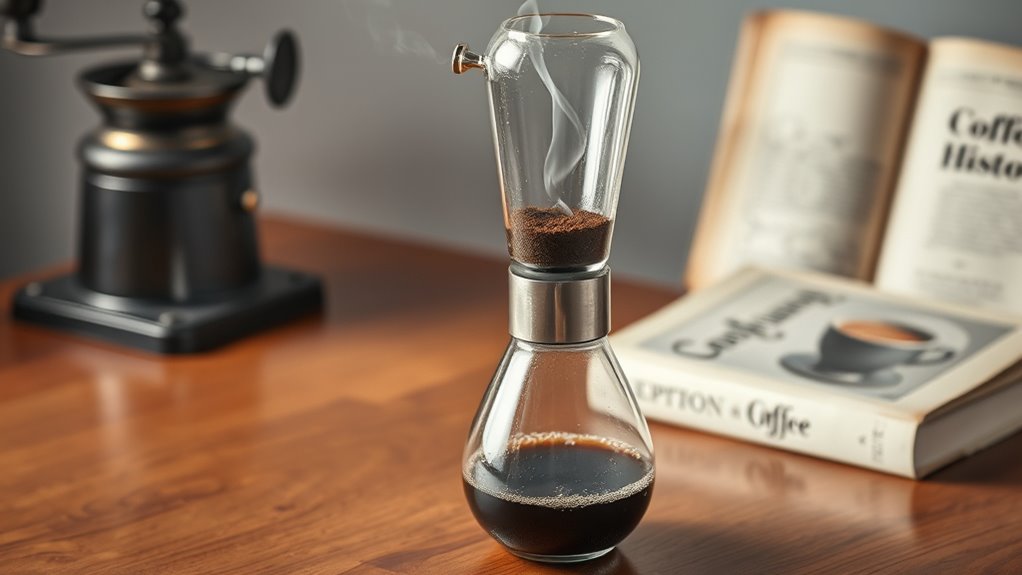
The history of the siphon brewer dates back to the mid-1800s when innovators sought to enhance coffee’s flavor by preventing boiling. The first patent for a siphon brewer was filed by Loeff of Berlin in the 1830s, marking the dawn of vacuum coffee technology.
This brewing method gained traction thanks to Mme. Vassieux, who designed the first commercially successful vacuum coffee brewer, making it popular in households.
Another significant development was the Napier Coffee Pot, awarded in 1856, recognized as one of the earliest examples of vacuum brewing technology.
A Theatrical Brewing Method
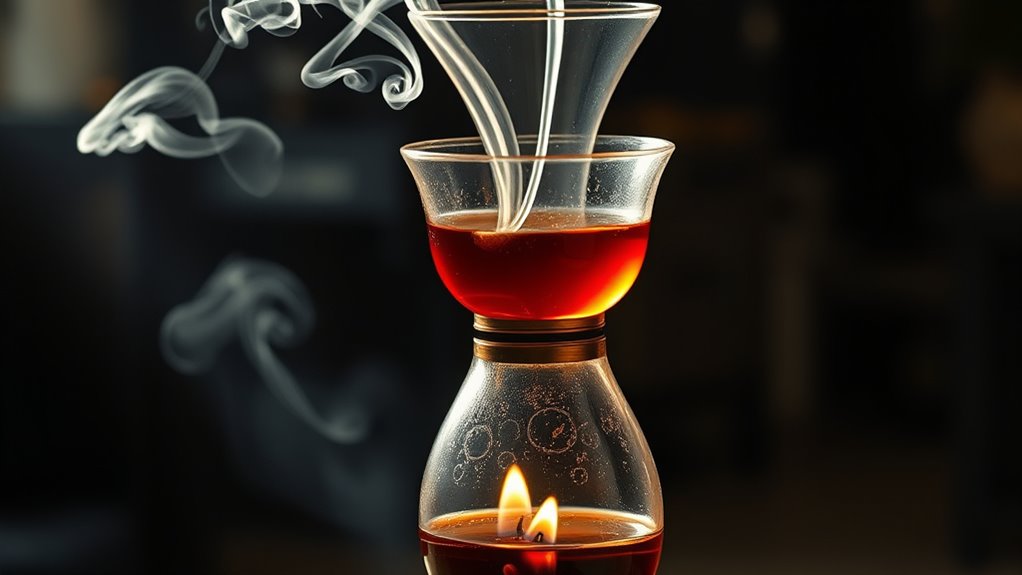
Siphon brewing isn’t just about making coffee; it’s an experience that captivates the senses. This visually engaging method turns the preparation of specialty coffee into a theatrical performance.
As you watch, the coffee maker showcases the science behind brewing, involving two chambers that work in harmony.
- The lower chamber heats water, creating vapor pressure.
- The pressure forces water into the upper chamber, mixing with coffee grounds.
- Gravity pulls the brewed coffee back down when it cools.
- A vacuum forms, guiding the liquid through a filter.
This process highlights the intricate mechanics of siphon brewing.
This method showcases the captivating mechanics of siphon brewing, blending science and artistry in every cup.
Not only does it produce unique flavors, but it also transforms your coffee-making experience into an interactive spectacle, leaving you and your guests in awe.
How a Siphon Brewer Works

While you might be familiar with traditional coffee-making methods, understanding how a siphon brewer works reveals the fascinating mechanics at play. This coffee maker consists of two chambers: the lower chamber holds water, while the upper chamber is designated for coffee grounds. As you heat the water in the lower chamber, vapor pressure builds, pushing the water up through a siphon tube into the upper chamber. Once the brewing process is complete, cooling creates a vacuum in the lower chamber, pulling the brewed coffee down through a filter.
| Step | Action | Result |
|---|---|---|
| 1 | Heat lower chamber | Generate vapor pressure |
| 2 | Water rises to upper chamber | Mix with coffee grounds |
| 3 | Brewing occurs | Flavor extraction |
| 4 | Cool down | Create vacuum |
| 5 | Brewed coffee pulls through filter | Ready to serve |
Siphon Brewing Today

Today, siphon brewing is capturing the attention of coffee enthusiasts, especially in specialty cafes. This unique method brews coffee using two chambers, harnessing vapor pressure and gravity to create a theatrical experience.
Here are a few reasons why siphon coffee makers, like Yama and Hario, are becoming popular:
- Distinctive flavor profile: Enhances subtler flavors in coffee beans.
- Theatrical brewing process: A visual delight in dedicated siphon bars.
- Modern siphon brewers: More accessible than ever, with affordable options available.
- Specialty coffee shops: A staple for unique coffee experiences.
- Quality performance: Maintains high standards comparable to premium models.
Siphon Brewing at Home

For coffee lovers enthusiastic to elevate their brewing game, siphon brewing at home offers a unique and rewarding experience.
To start, you’ll need a siphon coffee maker and a quality grinder. Aim for a coffee-to-water ratio of 7 grams of coffee per 100ml of water for ideal flavor extraction.
Using a butane or cloth wick burner, heat the water in the lower chamber until it boils, creating vapor pressure that forces water into the upper chamber.
After brewing, the coffee is pulled back down through a cloth filter, showcasing the fascinating vacuum process.
To keep your siphon coffee maker in top shape, make sure to clean the siphon brewer thoroughly after each use for the best results.
Frequently Asked Questions
What Is the Point of Siphon Coffee?
The point of siphon coffee is to elevate your brewing experience.
You’ll enjoy a visually striking process that combines science and aesthetics. As you watch water vapor force its way through coffee grounds, you’ll appreciate the enhanced flavors that emerge.
This method allows for precise control over brewing variables, letting you customize your cup.
Ultimately, siphon coffee creates a smooth, balanced brew, making it a favorite among coffee enthusiasts seeking something special.
What Are the Disadvantages of a Drip Coffee Maker?
Drip coffee makers have several disadvantages. You might find their flavor profiles lacking complexity, as they often don’t extract subtle notes effectively.
They usually brew a limited number of cups, making them less ideal for larger gatherings. Plus, the reliance on paper filters can absorb oils, resulting in a less rich taste.
Finally, without precise temperature control, your coffee’s flavor can suffer, and cleaning can be a hassle due to residue buildup.
What Is the Fuel for the Siphon Coffee Maker?
Imagine standing by a flickering campfire, the warmth wrapping around you as you brew coffee.
For your siphon coffee maker, you’ll want to use denatured alcohol, isopropyl alcohol, or butane. Denatured alcohol’s popular for traditional brewers, while butane offers better flame control.
Choosing high-quality fuel’s essential to prevent off-flavors and guarantee a clean burn, making your brewing experience as enjoyable as sharing stories by that campfire.
Is Siphon Coffee Better Than Pour Over?
You might find siphon coffee to be better than pour-over, especially if you appreciate a smoother, more balanced cup.
The unique brewing method enhances flavor extraction, providing a richer experience.
Plus, the vacuum effect allows for precise temperature control, preventing over-extraction that often happens with pour-over.
If you enjoy a visually engaging process, siphon brewing offers that theatrical element, making your coffee ritual not just about taste, but also about the experience.
Conclusion
Siphon coffee isn’t just about brewing; it’s an experience that combines art and science. Did you know that the siphon method can extract flavors at a temperature of around 200°F, resulting in a cup that’s both rich and aromatic? With its theatrical flair and unique brewing process, it’s no wonder that many coffee aficionados are drawn to this method. So why not give it a try at home? You might just discover your new favorite way to enjoy coffee!
